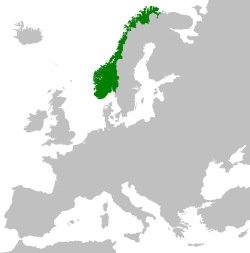
Back مملكة النرويج (1814) Arabic نوروژ کراللیغی (۱۸۱۴) AZB Rouantelezh Norge (1814) Breton Norské království (1814) Czech Reino de Noruega (1814) Spanish نروژ در ۱۸۱۴ Persian Norjan kuningaskunta (1814) Finnish Royaume de Norvège (1814) French Regno di Norvegia (1814) Italian 노르웨이 왕국 (1814년) Korean
This article needs additional citations for verification. (April 2023) |
Kingdom of Norway Kongeriget Norge | |||||||||||
|---|---|---|---|---|---|---|---|---|---|---|---|
| 25 February – 4 November 1814 | |||||||||||
| Motto: Enig og tro til Dovre faller Et usque ad perfectum est unitum montibus Dovre iactata fatiscit "United and loyal until the mountains of Dovre crumble" Royal motto Gud og fædrelandet "God and the fatherland" | |||||||||||
| Anthem: Norges Skaal "Norway’s Toast" | |||||||||||
 The Kingdom of Norway in 1814 | |||||||||||
| Status | De facto state | ||||||||||
| Capital | Christiania | ||||||||||
| Largest city | Bergen[1] | ||||||||||
| Common languages | Dano-Norwegian koiné, Danish written, Norwegian dialects, Sami languages | ||||||||||
| Religion | Lutheranism | ||||||||||
| Demonym(s) | Norwegian | ||||||||||
| Government | Constitutional monarchy | ||||||||||
| King | |||||||||||
• 1814 | Christian Frederick | ||||||||||
| First Minister | |||||||||||
• 1814 | Frederik Gottschalk von Haxthausen | ||||||||||
| Legislature | Storting | ||||||||||
| Lagting | |||||||||||
| Odelsting | |||||||||||
| Historical era | Napoleonic Wars | ||||||||||
| 14 January 1814 | |||||||||||
| 16 February 1814 | |||||||||||
| 17 May 1814 | |||||||||||
| 26 July 1814 | |||||||||||
| 14 August 1814 | |||||||||||
| 4 November 1814 | |||||||||||
| Population | |||||||||||
• 1814[2] | 902,100 | ||||||||||
| Currency | Rigsdaler | ||||||||||
| ISO 3166 code | NO | ||||||||||
| |||||||||||
| Today part of | Norway | ||||||||||
In 1814, the Kingdom of Norway made a brief and ultimately unsuccessful attempt to regain its independence. While Norway had always legally been a separate kingdom, since the 16th century it had shared a monarch with Denmark; Norway was a subordinate partner in the combined state, whose government was based in Copenhagen. Due to its alliance with France during the Napoleonic Wars, Denmark was forced to sign the Treaty of Kiel in January 1814 ceding Norway to Sweden.
However, many Norwegians were inspired by the rising tide of nationalism and resented being handed over without their consent to Sweden, a state they viewed as a traditional rival. Under the leadership of Christian Frederick, who was the Danish government's representative in Norway and also the king of Denmark's cousin and heir presumptive, Norway attempted to assert its rights as an independent state. A government was established and a constitution written, under which Christian Frederick was elected king of Norway in May 1814.
The fledgeling Norwegian state was unable to gain support or recognition from any foreign powers, and was defeated in a two-week war with Sweden in the summer of 1814. However, the Convention of Moss, signed at the end of the war in August, preserved many of the independence movement's achievements: Norway remained mostly autonomous in a personal union with Sweden, and was permitted to retain its new constitution with only slight modifications. Christian Frederick, forced to abdicate as king of Norway, would become king of Denmark as Christian VIII in 1839. Norway would eventually fully break away from Sweden in 1905.
- ^ [1] Archived 24 December 2022 at the Wayback Machine, SNL. Retrieved on 17 January 2023.
- ^ Demographics of Norway Archived 11 October 2017 at the Wayback Machine, Jan Lahmeyer. Retrieved on 8 March 2014.
- ^ "Unike dokument viser Larviks danske hemmelegheit". 26 June 2021. Archived from the original on 26 June 2021. Retrieved 26 June 2021.

